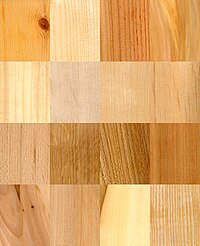
Photo from wikipedia
In this work, we report a new facile method for the preparation of myrcene-limonene copolymers and nanocomposites using a Lewis acid as a catalyst (AlCl3) and organo-modified clay as a… Click to show full abstract
In this work, we report a new facile method for the preparation of myrcene-limonene copolymers and nanocomposites using a Lewis acid as a catalyst (AlCl3) and organo-modified clay as a nano-reinforcing filler. The copolymer (myr-co-lim) was prepared by cationic copolymerization using AlCl3 as a catalyst. The structure of the obtained copolymer is studied and confirmed by Fourier Transform Infrared spectroscopy, Nuclear Magnetic Resonance spectroscopy, and Differential Scanning Calorimetry. By improving the dispersion of the matrix polymer in sheets of the organoclay, Maghnite-CTA+ (Mag-CTA+), an Algerian natural organophilic clay, was used to preparenanocomposites of linear copolymer (myr-co-lim). In order to identify and assess their structural, morphological, and thermal properties, the effect of the organoclay, used in varyingamounts (1, 4, 7, and 10% by weight), and the preparation process were investigated. The Mag-CTA+ is an organophylic montmorillonite silicate clay prepared through a direct exchange process in which they were used as green nano-reinforcing filler. The X-ray diffraction of the resulting nanocomposites revealed a considerable alteration in the interlayer spacing of Mag-CTA+. As a result, interlayer expansion and myr-co-lim exfoliation between layers of Mag-CTA+ were observed. Thermogravimetric analysis provided information on the synthesized nanocomposites’ thermal properties. Fourier transform infrared spectroscopy and scanning electronic microscopy, respectively, were used to determine the structure and morphology of the produced nanocomposites (myr-co-lim/Mag). The intercalation of myr-co-lim in the Mag-CTA+ sheets has been supported by the results, and the optimum amount of organoclay needed to create a nanocomposite with high thermal stability is 10% by weight. Finally, a new method for the preparation of copolymer and nanocomposites from myrcene and limonene in a short reaction time was developed.
Journal Title: Polymers
Year Published: 2022
Link to full text (if available)
Share on Social Media: Sign Up to like & get
recommendations!